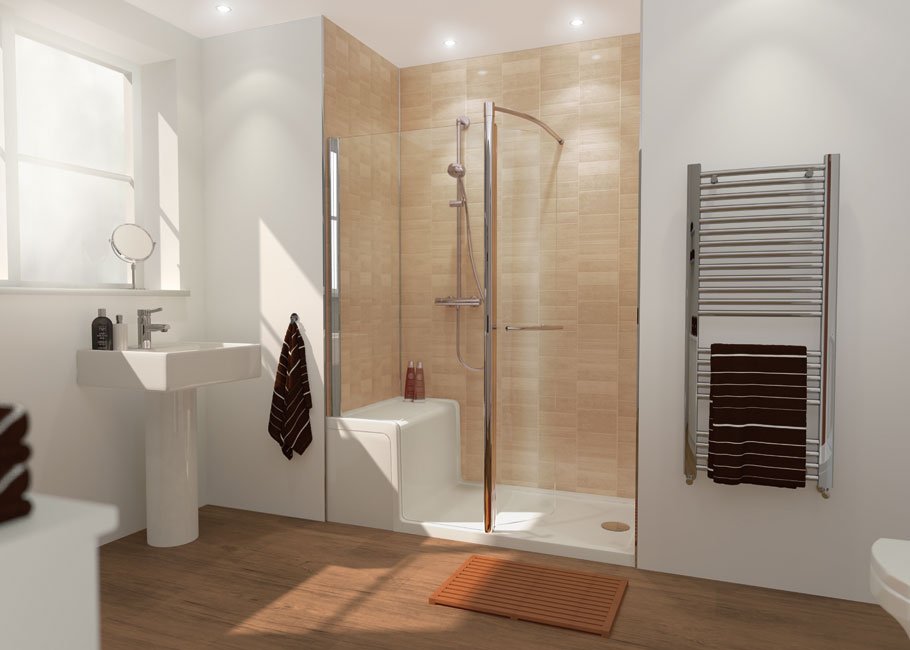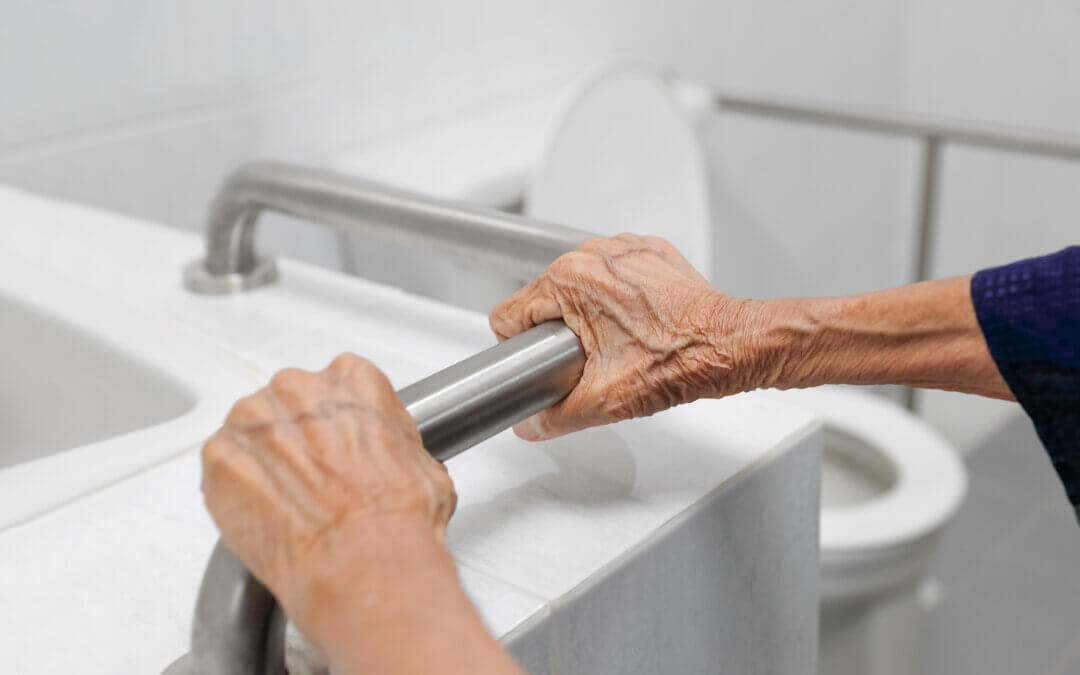
As people age or live with disabilities, bathing can become more challenging. Level access showers have emerged as an effective solution, providing a safe and barrier-free showering experience.
In this article, we’ll delve into the benefits of level access showers, discussing their different types, and how they differ from traditional walk-in showers. By the end, you will know exactly how level access showers can make bathing safer and more enjoyable for the elderly and those with limited mobility.
Get a FREE Brochure
Simply complete our form to see a full range of bathing solutions & their key features. It takes no time at all!
- What is a level access shower?
- What are the benefits of level access showers?
- What is the difference between a walk-in shower and a level access shower?
- Types of level access shower
- FAQs
What is a level access shower?
A level access shower is like a regular shower, except it has no threshold to step over. Instead, the shower floor is level with the bathroom floor, making it easy for elderly people and wheelchair users to get in and out.
For the elderly and people with disabilities, level access showers can be extremely beneficial. That is because many people with mobility issues find it difficult – or even impossible – to step over a traditional shower threshold, which can be a major barrier to independent bathing. By eliminating the threshold, a level access shower makes it possible for everyone to enter and exit the shower safely and easily.
You can even find level access showers with additional disability bathing safety features like grab bars and non-slip surfaces to further enhance safety and accessibility when showering, helping to prevent slips and falls, and making it easier for people with mobility issues or the elderly to move around in the shower.
Level access showers can be a key component in creating a safe and accessible bathroom environment, allowing you to regain independence and dignity while carrying out everyday personal hygiene routines.
What are the benefits of level access showers?
Level access showers provide several benefits for the elderly, wheelchair users and people with limited mobility:
Improved accessibility
Mobility showers are designed to be completely flat, with no steps or barriers that can obstruct entry or exit. This makes them ideal for people with mobility impairments, including wheelchair users, who may find it difficult or impossible to navigate a traditional shower that has a raised threshold.
Safer than regular showers
Level access showers are designed with safety in mind. They typically have non-slip surfaces, which can help prevent slips and falls, particularly for older adults who may be at a higher risk of falling. Additionally, level access showers can be fitted with handrails or grab bars, which can provide extra support and stability for people who need it.
Increased independence
By providing an accessible, safe and easy-to-use experience, level access showers can help people with disabilities and the elderly maintain independence and privacy. Anyone can use the shower on their own, without having to rely on someone else for assistance.
More comfortable than regular showers
Level access showers are typically larger than traditional showers, which can provide more space and comfort for users. This is particularly important for wheelchair users, who need extra space to move around.
Stylish options available
These types of showers can be designed with style in mind, with a range of materials and finishes to choose from. This can help create a bathroom that is both functional and beautiful.
What is the difference between a walk-in shower and a level access shower?
A walk-in shower has a low threshold or step to enter, typically a few inches high, with the shower floor normally sloped towards a drain to prevent water from accumulating. The term ‘walk-in shower’ is often used to refer to showers enclosed with glass or curtains, either with a door or an open entrance.
A level access shower is a type of shower that has no step or threshold. The shower floor is completely level with the surrounding bathroom floor and is typically designed to be open, without doors or curtains. However, they can be enclosed if desired.
The main difference between walk-in showers and level access showers is the presence of a threshold. While walk-in showers have a low threshold, level access showers have no threshold at all, making them completely accessible for people with mobility impairments, including wheelchair users.
Both walk-in showers and level access showers can be designed to be stylish and functional, with a range of materials, finishes and features to choose from. However, for people with disabilities or mobility impairments, a level access shower may be a better option, as it provides a completely barrier-free showering experience, allowing for maximum independence and safety.
Types of level access shower
There are several types of level access mobility showers available, including:
Wet room
Wet rooms are completely open shower areas that have a sloping floor and a drain. Typically enclosed by a glass partition or curtain, they may have a shower screen to prevent water from splashing onto the surrounding bathroom. Wet rooms are highly accessible and can be customised to meet the specific needs of wheelchair users and the elderly.
Low-profile shower tray
A low-profile shower tray is a shower base that sits flush with the surrounding floor. It normally has a slight slope towards a central drain and can be customised to fit the specific dimensions of the bathroom. Low-profile shower trays are a good option for those who want a level access shower but prefer some level of containment.
Ramp-access shower tray
A ramp-access shower tray is a shower base that has a gradual slope leading up to it, allowing wheelchair users to enter directly into the shower. While highly accessible, these showers may require more space in the bathroom to accommodate the ramp.
Modular shower
This is a prefabricated shower unit that can be installed in any space, usually including a low-profile shower tray, walls, and a shower door or curtain. Modular showers are easy to install and can be customised to meet the specific needs of the user.
When it comes to selecting a level access shower for the elderly, wheelchair users and those with mobility issues, a wet room or a ramp-access shower tray are often the best options.
Wet rooms provide maximum accessibility and can be customised to meet specific needs, while ramp-access shower trays provide a gentle slope that allows for easy wheelchair access. Ultimately, the type of shower that is best for any individual will depend on their specific needs and the layout of their bathroom.
FAQs
Is it necessary to have a wet room for an accessible bathroom?
No, it is not necessary to have a wet room. You can install a level access shower tray and recess it into the floor to provide a completely level access solution – similar to a wet room.
Do level access showers easily flood?
No, level access showers do not easily flood as long as they are installed by a well-trained and fully competent installer. Our shower trays and wet room installations have falls in them at the perfect gradient, allowing water to run down towards the drain.
Do level access showers look unattractive?
No, you can design your level access mobility walk-in shower or walk-in bath to look stylish and luxurious. For instance, a wet room can have stylish tiling or non-slip safety flooring in a range of colours, while a shower tray can have tiled walls and a stylish glass shower screen, making the bathroom more stylish and practical.
Are level access showers difficult to install?
No, level access showers, particularly wet rooms, are relatively straightforward to install. The installation process can be completed in a matter of days, depending on the room’s size and amount of tiling required, causing minimal disturbance to the person’s home.






